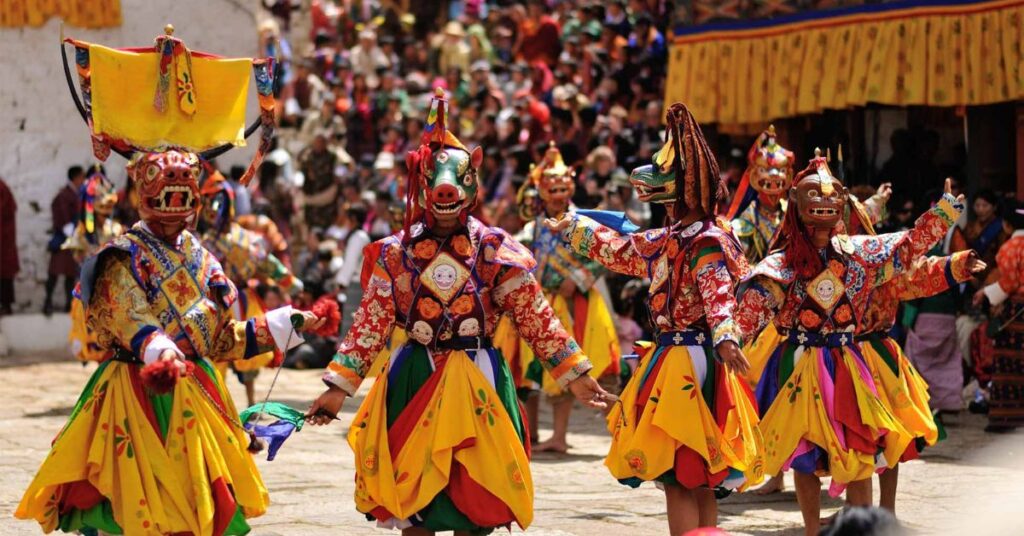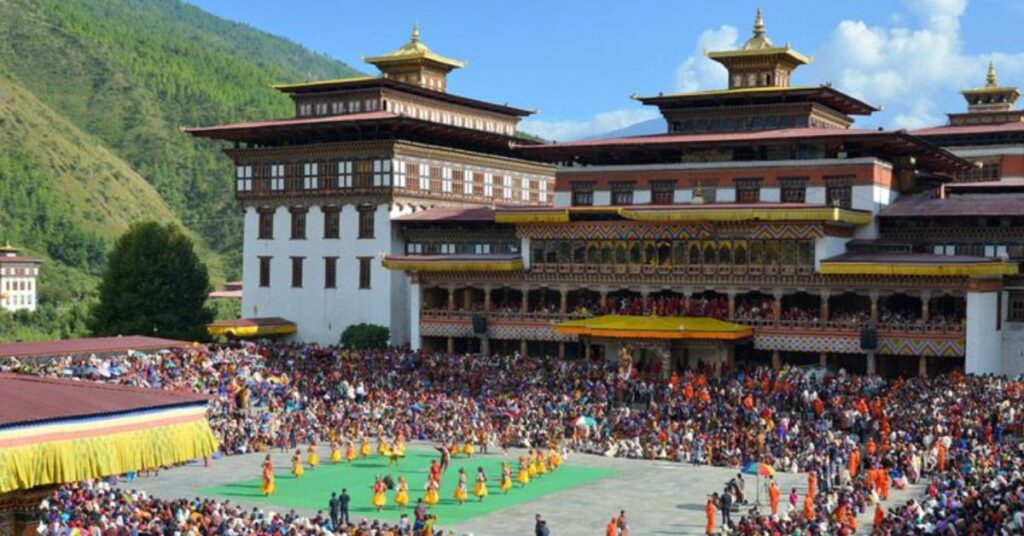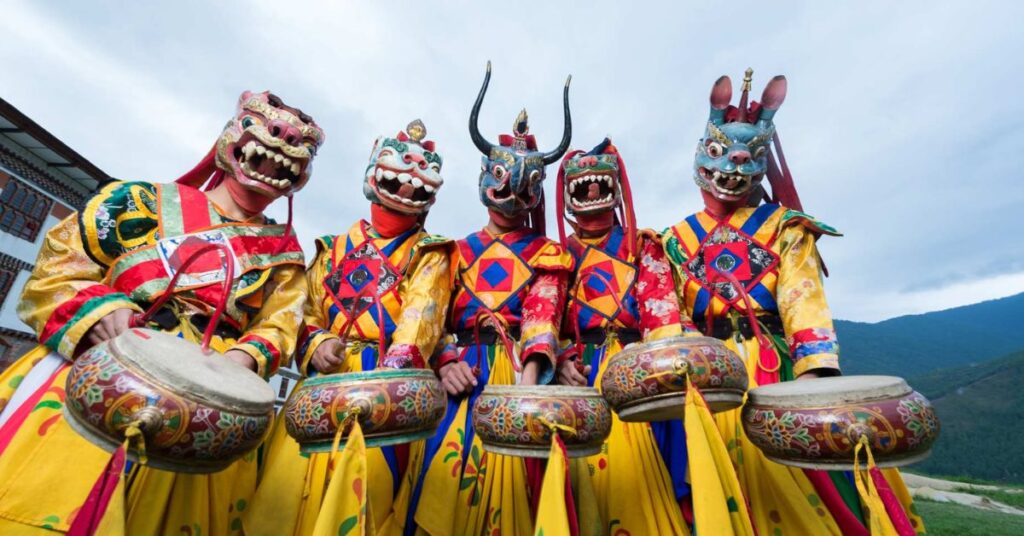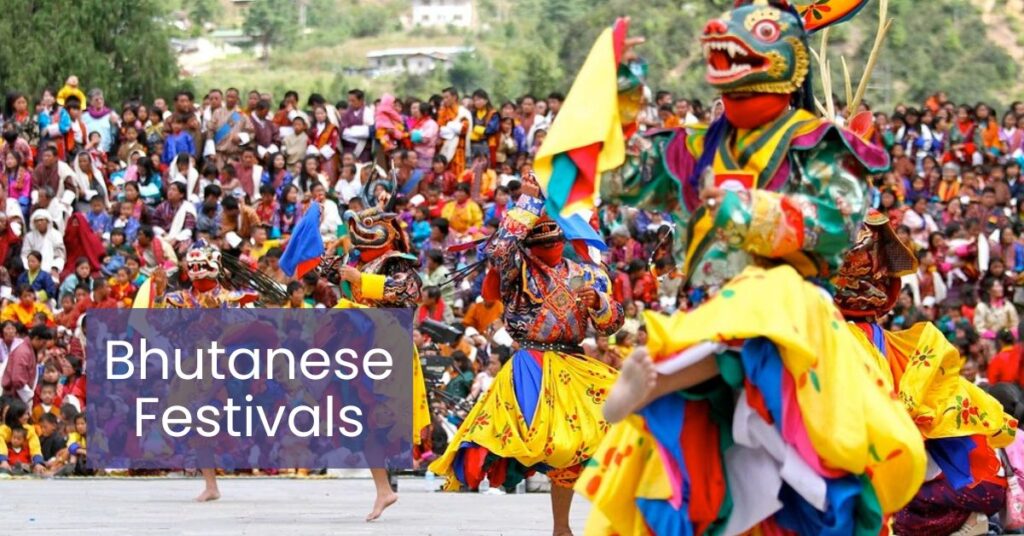Bhutan, a small Himalayan kingdom known for its breathtaking landscapes and deeply spiritual culture, offers a unique window into its traditions through its colorful festivals. These celebrations, known as Tsechus, are not just events but an integral part of Bhutanese life. They serve as a profound expression of the country’s rich heritage, religious devotion, and communal harmony. Attending a festival in Bhutan provides a supreme cultural experience, allowing visitors to witness the essence of Bhutanese spirituality and festivity.
Introduction to Bhutanese Festivals
Bhutanese festivals, or Tsechus, are grand religious events held annually across various dzongs (fortresses) and monasteries. Rooted in Buddhist teachings, these festivals honor Guru Rinpoche, the “Second Buddha,” whom people believe to brought Buddhism to Bhutan in the 8th century. Tsechus are characterized by their colorful mask dances, known as Cham dances. The dances are performed by monks and laypeople in elaborate costumes. These dances, steeped in symbolism, are meant to bless the audience and ward off evil spirits, creating a spiritually uplifting atmosphere for all who attend.

Key Festivals in Bhutan
Thimphu Tshechu Festival
The Thimphu Tsechu is one of Bhutan’s most renowned and widely attended festivals. The festival is held annually in the capital city, Thimphu. It was initiated by the 4th Temporal Ruler, Tenzin Rabgye, in 1670. This festival is a major highlight for both locals and visitors, drawing crowds to the grand Tashichho Dzong.
The Thimphu Tsechu spans several days, typically in late September or early October. It is celebrated with a series of Cham dances that depict stories from Buddhist mythology, each dance carrying deep spiritual significance. The festival is also a time for socializing, where people from all walks of life come together in their finest traditional attire, known as Gho for men and Kira for women.
Visitor Experience:
- Dates: September 13 – 15, 2024.
- What to Expect: Visitors can expect a vibrant display of culture, with stunning mask dances, traditional music, and a lively atmosphere. The festival also offers a chance to engage with Bhutanese locals, making it a deeply immersive cultural experience.
Paro Tsechu Festival
The Paro Tsechu is another major festival celebrated in the historic town of Paro. Known for its grandeur, the festival is highlighted by the unveiling of the Thongdrel, a massive silk Thangka (religious painting) that is revealed to the public at dawn.
The Paro Tsechu takes place in the majestic Rinpung Dzong, with the Thongdrel being displayed on the final day of the festival. This Thangka, measuring several stories high, depicts Guru Rinpoche and is believed to confer blessings on those who view it. The festival also features a series of Cham dances, similar to those in Thimphu, but with its unique local flavor.
Unique Experiences:
- Spiritual Significance: Viewing the Thongdrel is a profound experience, believed to cleanse one of all sins.
- Cultural Immersion: The Paro Tsechu offers a deep dive into Bhutanese religious practices, set against the backdrop of Paro’s stunning landscape.
Visitor Experience:
- Dates: 8 – 12 April 2025.
- What to Expect: A blend of spiritual rituals, traditional performances, and the breathtaking surroundings of Paro. It’s also an excellent time to explore nearby attractions such as the Tiger’s Nest Monastery.
Punakha Drubchen and Tsechu
Description: The Punakha Drubchen and Tsechu commemorate Bhutan’s historic victory over Tibetan forces in the 17th century. These festivals combine historical reenactments with traditional Cham dances, making them a unique cultural experience.
The Drubchen features dramatic reenactments of the battle where Bhutanese forces, led by the Zhabdrung Ngawang Namgyal, defended the Punakha Dzong against Tibetan invaders. The Tsechu that follows includes traditional Cham dances, adding a spiritual dimension to the historical celebrations.
Cultural Significance:
- Historical Importance: The festival honors Bhutan’s independence and the bravery of its people.
- Spiritual Elements: Locals believe the Tsechu dances purify the area and the people, ensuring peace and prosperity.
Visitor Experience:
- Dates: March 5 – 13, 2025.
- What to Expect: A blend of historical drama and spiritual rituals, set in the scenic Punakha Valley. Visitors can also explore the Punakha Dzong, one of Bhutan’s most beautiful and significant fortresses.
Jambay Lhakhang Drup
The Jambay Lhakhang Drup is one of Bhutan’s oldest and most mystical festivals, held at the Jambay Lhakhang temple in Bumthang. This festival is famous for its fire rituals and the Tercham, or naked dance, performed in the dead of night.
The Jambay Lhakhang Drup includes a series of sacred rituals, including the Mewang, or fire blessing, where participants leap over flames to purify their souls. Monks perform the Tercham, , which symbolizes the power of enlightenment over ignorance and ithey believe it brings fertility and good fortune. The festival also includes Cham dances, making it a deeply spiritual event.
Origins and Spiritual Significance:
- Historical Roots: The festival dates back to the 7th century when King Songtsen Gampo of Tibet built the Jambay Lhakhang temple.
- Spiritual Importance: Participants perform rituals during the festival to cleanse themselves of sins and draw closer to spiritual enlightenment.
Visitor Experience:
- Dates: November 15 – 18, 2024.
- What to Expect: A unique and spiritually charged festival experience, set in the remote and serene Bumthang Valley. The festival’s intimate setting allows for close interaction with the rituals and the local community.
Haa Summer Festival
The Haa Summer Festival is a lesser-known but culturally rich event held in the Haa Valley. This festival celebrates the unique customs, food, sports, and traditional arts of the Haa region, offering a different perspective on Bhutanese culture.
The festival includes traditional Bhutanese sports such as archery and yak riding, as well as displays of local crafts and cuisine. It is a celebration of the Haa Valley’s pastoral lifestyle, providing visitors with a rare glimpse into the daily life of the region’s residents.
Cultural Preservation:
- Local Traditions: The Haa Summer Festival plays a crucial role in preserving and showcasing the cultural heritage of the Haa Valley.
- Community Engagement: The festival offers an authentic experience, where visitors can engage directly with the local community and participate in their customs.
Visitor Experience:
- Dates: Held in July, Dates not finalized yet.
- What to Expect: A more relaxed and authentic festival experience, away from the tourist crowds. The Haa Summer Festival is ideal for those looking to explore Bhutan’s rural life and natural beauty.

The Significance of Bhutan Mask Dances
Monks and laypeople perform Cham dances, or mask dances, at the heart of Bhutanese festivals, showcasing intricate costumes and masks. These dances are more than just performances; they are deeply symbolic rituals that convey religious teachings and moral lessons.
Spiritual Symbolism:
- Deities and Demons: The dances often depict deities subduing demons, symbolizing the victory of good over evil.
- Ritual Purification: Devotees believe The Cham dances purify the environment, dispel negative energies, and bring blessings to the community.
Visual and Cultural Impact:
- Costumes and Masks: The elaborate costumes and masks worn by the dancers are works of art, each carrying specific meanings related to the characters they represent.
- Cultural Preservation: The dances are an essential part of Bhutan’s cultural heritage, passed down through generations, and performed with great reverence.
Planning Your Visit: Bhutan Festival Dates
To fully experience Bhutan’s festivals, it’s essential to plan your visit around the festival calendar. Most major festivals occur during the spring and autumn, which are also the best times to visit Bhutan due to the favorable weather conditions.
Booking and Travel Tips:
- Accommodation: Book your stay well in advance, as festival periods are peak tourist seasons.
- Guides: Hiring a local guide can enhance your experience by providing deeper insights into the rituals and cultural significance of the festivals.
- Permits: Ensure you have the necessary permits, especially if you plan to visit restricted areas or remote festivals.

The Cultural Experience of Bhutanese Festivals
Attending a festival in Bhutan is not just about witnessing a spectacle. It’s about immersing yourself in the country’s spiritual and cultural life. The festivals offer a rare opportunity to connect with Bhutanese traditions, engage with the local community, and gain a deeper understanding of Bhutan’s unique way of life.
Respecting Local Customs:
- Dress Code: Visitors should try to wear traditional Bhutanese attire during festivals. This not only shows respect but also enhances the immersive experience.
- Photography: While you can generally take photos, it’s essential to show respect, especially during sacred rituals
- Participation: Engage with the festivities, but always be mindful of the spiritual significance of the events.
Closing Words
Bhutan’s festivals are a vibrant expression of the country’s cultural and spiritual heritage. If you feel close to the grandeur of the Thimphu Tsechu or the intimate rituals of the Jambay Lhakhang Drup, these festivals will offer you a unique opportunity to experience Bhutan’s rich traditions firsthand. By planning your visit around these events, you’ll gain a deeper appreciation for the beauty and depth of Bhutanese culture. Which will make your journey to the Land of the Thunder Dragon truly unforgettable.
FAQs
Locals consider The Thimphu Tsechu as the main festival, known for its grand celebrations in the capital city.
All Tsechus are cultural festivals, but the Paro Tsechu is especially notable for its significant rituals and large-scale events.
The Thimphu Tsechu and Paro Tsechu are among the most famous festivals, attracting large crowds and international visitors.
The term “Tsechu” refers to Bhutanese festivals featuring traditional Cham dances performed by monks and locals.
Note: Please don’t litter and keep the environment clean.

